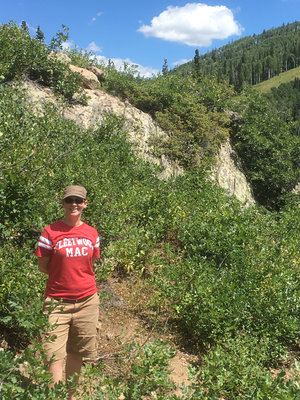Faculty/Staff Directory

- Assistant Professor
BIO 121 General Biology II
BIO 376 Genetics Laboratory
BIO
413 Freshwater Algae
I study algae and primarily work with diatoms, a group of algae with silica cell walls. I have a number of ongoing projects, but I am always interested in developing new studies with interested students. If you’re interested in algae and gaining some research experience, please reach out to me via email.
Current project examples:
I am part of a collaborative study of the microbial mats that live in a high sulfur, low oxygen submerged sinkhole habitat in Lake Huron. These mats live in conditions similar to early Earth. We are studying the diversity and functionality of these mats using molecular tools (metabarcoding and metatranscriptomics).
I am part of another collaborative study of the Rhopalodiales, a group of diatoms with cyanobacterial endosymbionts. The Rhopalodiales utilize their cyanobacterial partners to fix atmospheric nitrogen, but the evolution of this relationship is not well understood. We will be using culture studies and genomic sequence data to reveal these relationships.
Assistant Research Professor, Temple University, Biology,
2017-2018.
Post-doctoral Fellow, University of Colorado, Boulder,
Museum of Natural History, 2012-2013.
Ph.D., University of New
Brunswick, Fredericton, Biology, 2007-2012.
Diploma in University
Teaching, University of New Brunswick, Fredericton, 2010.
M.S.,
Ohio University, Environmental and Plant Biology, 2001-2003.
B.S.,
Juniata College, Writing and the Environment, 1995-1999.
Hamsher SE, Ellis K, Holen D, Sanders, RW. 2020. Effects of light, dissolved nutrients and prey on ingestion and growth of a newly identified mixotrophic alga, Chrysolepidomonas dendrolepidota (Chrysophyceae). Hydrobiologia 847: 2923–2932. https://doi.org/10.1007/s10750-020-04293-z
Hamsher SE, Keepers KG, Pogoda CS, Stepanek JG, Kane NC, Kociolek JP. 2019. Extensive chloroplast genome rearrangement amongst three closely related Halamphora spp. (Bacillariophyceae), and evidence for rapid evolution as compared to land plants. PLOS One, 14: e0217824. https://doi.org/10.1371/journal.pone.0217824
Pogoda CS, Keepers KG, Hamsher SE, Stepanek JG, Kane NC, Kociolek JP. 2018. Comparative analysis of the mitochondrial genomes of six newly sequenced diatoms reveals group II introns in the barcoding region of cox1. Mitochondrial DNA Part A, https://doi.org/10.1080/24701394.2018.1450397
Hamsher SE, Sung CYT, Sanders RW. 2017. Effects of temperature and photorepair radiation on a marine ciliate exposed to UVB radiation. Journal of Eukaryotic Microbiology. 65: 458–467. https://doi.org/10.1111/jeu.12491
Kociolek JP, Hamsher SE, Kulikovskiy M, Bramburger AJ. 2017. Are there species flocks in freshwater diatoms? A review of past reports and a look to the future. Hydrobiologia. 792: 17–35. https://doi.org/10.1007/s10750-016-3075-1
Hamsher SE, Graeff CL, Stepanek JG, Kociolek JP. 2014. Frustular morphology and polyphyly in freshwater Denticula (Bacillariophyta) species, and the description of Tetralunata gen. nov. (Epithemiaceae, Rhopalodiales). Plant Ecology and Evolution. 147: 346–365. https://doi.org/10.5091/plecevo.2014.990
Hamsher SE, Evans KM, Mann DG, Poulickova A, Saunders GW. 2011. Barcoding diatoms: exploring alternatives to COI-5P. Protist. 162: 405–422. https://doi.org/10.1016/j.protis.2010.09.005
Hamsher SE, Verb RG, Vis ML. 2004. Analysis of acid mine drainage impacted streams using a periphyton index. Journal of Freshwater Ecology. 19: 313–324. https://doi.org/10.1080/02705060.2004.9664546
Back
